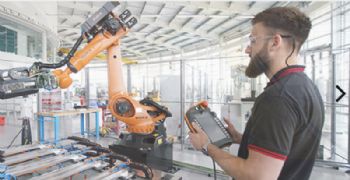
Engineers at the University of Sheffield Advanced Manufacturing Research Centre (AMRC) (
www.amrc.co.uk) are leading the way in collaborative robotics research in a drive to help SMEs integrate this technology into their production facilities.
Collaborative robots — also known as cobots — differ from conventional industrial robots in that they feature technology that allows them to operate safely alongside human workers in a shared area.
They are capable of operating with limited force and speed, and they are equipped with force-sensing to enable them to stop when they come into contact with an operator.
A project that began in May last year and was completed in March this year had the aim of developing a ‘gold standard’ in cobot safety that could increase confidence among SMEs to adopt this technology and transform their production lines.
As part of this work, a cell was created at the AMRC’s Factory 2050 to demonstrate cobot safety and show potential adopters the usefulness of the technology and that it can be industrialised.
Phil Kitchen, who led this project, said: “There are a number of benefits of collaborative robotics for SMEs, including improved quality and productivity.
A technical specification has been released, which details how to go about integrating a collaborative robotic system. It’s not yet been ratified as a full ISO standard to use, but that is being worked towards now.
“A good example of cobot application is a project we did for a Tier One AMRC member.
They had a process where they apply adhesive to fastening components before inserting them. Applying this adhesive is a manually demanding operation with a risk of repetitive strain injury.
"What our demonstrator showed was the robot picking up a fastener, presenting it to a head that distributed glue around the fastener and then handing the fastener to the operator to do the ‘dexterous’ task of putting it in the spar.”